East Anglia Man.
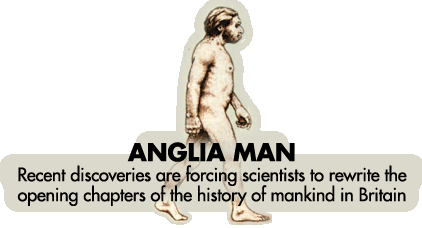
Research in East Anglia, and a new analysis of bones found two decades ago in a Somerset quarry, show that human beings have been living in Britain for up to 200,000 years longer than has generally been thought. Mankind's ancestors may have migrated here as long as 700,000 years ago.
Until now, the oldest evidence of early human beings, or hominids, in Britain came from about 500,000 years ago, the date attributed to Boxgrove Man, a member of the species Homo heidelbergensis whose remains were unearthed at Boxgrove in West Sussex in 1993.
The first results of the Ancient Human Occupation of Britain project, however, indicate that the first Britons are almost certainly much older. Animal remains found at a hominid settlement on the East Anglian coast have been dated to 700,000 years ago, indicating that "Anglia Man" is at least that old. A re-examination of animal bones and artefacts unearthed in the 1980s at Westbury-sub-Mendip, in Somerset, have shown evidence of early human activity 100,000 years before Boxgrove Man.
The revised date for Westbury alone, however, is being hailed as one of the most exciting developments in British archaeology and palaeontology since the Boxgrove finds.
"The evidence is starting to mount in favour of hominids having been here for a long time before Boxgrove," said Professor Chris Stringer, head of human origins at the Natural History Museum, and director of the Ancient Human Occupation of Britain project. "We don't yet have the hominid fossils, as we do for Boxgrove Man, but there are firm hints that settlement goes back as far as 700,000 years."
Andy Currant, from the museum's department of palaeontology, said: "We are getting big surprises. The dates are massively earlier than what we thought they were, by an order of 100,000 years."
Human remains, such as the tibia and teeth found at Boxgrove, have yet to be unearthed from older periods, but cut marks on animal bones and flints shaped into primitive hand-axes have been found at the new sites. Both are firm indicators that mankind's ancestors were present, because no other animal could account for them. At Westbury, for example, there are bones belonging to rhinoceroses, hyenas, wolves, bison and cave bears showing straight cut marks that could have been made only by butchery with a sharp cutting implement, along with shaped flints that have been newly identified as hand axes.
The dates involved are much too early for carbon dating - effective only to about 40,OOOBC - but scientists have been able to calculate good approximate ages from the known ages of animal fossils found at the sites.
In particular, the research centres on teeth belonging to a genus of prehistoric watervole, known as mimomys. About 700,000 years ago these voles had rooted molars, similar to those of human beings, which grow once then get worn down through adult life. But by 500,000 years ago, the animals had evolved rootless molars that continue to grow - an advantage to creatures that eat tough vegetation.
The voles found at Boxgrove are from the later era, but the East Anglian ones have primitive molars, dating the site definitively to at least 700,000 years ago. Those at Westbury are of an intermediate form. "The dating still involves some guesswork, but the best estimate is about 600,000 years ago," Professor Stringer said. Simon Parfitt, a fossil mammal specialist at the museum and at University College, London, who analysed the vole fossils, said; "We can put everything in a relative order, and Westbury could be 100,000 years earlier than Boxgrove. The Bast Anglian finds go as far back as 700,000 years."
The species of hominid which inhabited the sites remains unknowable without direct fossils. Professor Stringer said the most likely candidate is an earlier variety of Homo heidelergensis. It was also possible they were examples of Homo antecessor, a potentially new species found at Atapuerca in Spain and the oldest known European hominid.
Homo heidelergensis, as known from Boxgrove and continental sites, had a slightly smaller skull than modern man, but was more heavily built, at about 14 stone in weight and 6ft to height "In my view, it's a direct ancestor of Homo sapiens," Professor Stringer said.
The Ancient Human Occupation of Britain project, which was started last year with a grant from the Leverhulme Trust, is also examining human habitation in Britain since Boxgrove and aims to shed light on when, how and where hominids lived in these islands. A key question will be an investigation of a 100,000-year period in which early human beings appear to have been absent, probably because of climate change.
The Ancient Human Occupation of Britain study has brought together researchers from many different disciplines with the aim of building up a comprehensive history of human habitation in England and Wales. As well as archaeologists and palaeontologists, it involves geologists, geographers and specialists on fossil mammals. Geological data, for example, gives a good guide to dates and to local temperatures during particular epochs, while mammalian remains can be important for judging human lifestyles.

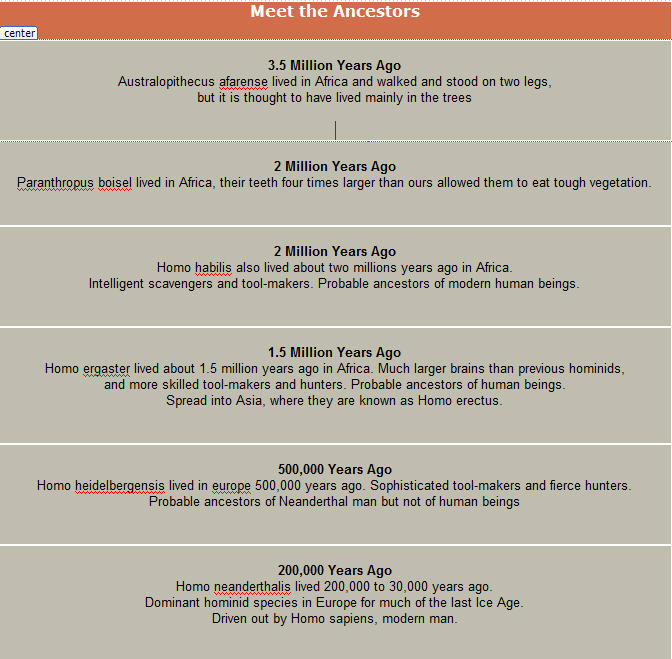
Roots of Man are Ten Times Older
While "Anglia Man" and his Somerset cousins appear to be by far the
earliest human beings to have reached Britain, the roots of mankind's
family tree stretch back almost ten times longer in Africa.
Last year, the oldest known human ancestor, Ardipithecus ramidus
kaddaba, who is up to 5.8 million years old. was unearthed in Ethiopia.
[see latest news] Before this, the earliest confirmed hominid was
Ardipithecus ramidia ramidus, who lived 4.4 million years ago.
Other scientists say that Orrorin tugenensis, or Millennium Man, at 6
million years old, is first in the line, but doubts remain about whether
he is part of the human family or another type of ape. Later on comes
Australopithecus afafensis, the 3.75 million-year-old species whose most
famous member is the Ethiopian fossil "Lucy". Homo erectus, the first
confirmed direct ancestor of Homo sapiens, evolved in Africa between 2
million and 1.5 million years ago,
Homo heidelbergensis, the species found at Boxgrove, and which was
probably also present at the East Anglian and Westbury sites, is thought
to have evolved at some time before 500,000 years ago. A possible
separate species, Homo antecessor, may have evolved in Spain at about
the same time. The latest species to evolve were Homo neanderthalis, or
Neanderthal man, which developed about 200,000 years ago, and Homo
sapiens - modem man.
Homo sapiens became anatomically modern in Africa about 100,000 years
ago, and developed modern forms of behaviour such as language up to
70,000 years ago.
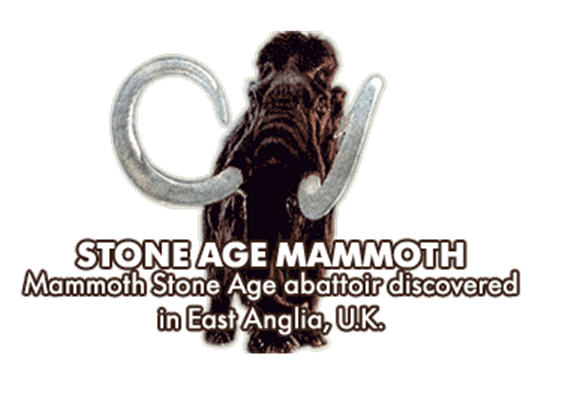
An extraordinary collection of mammoth remains and flint tools unearthed in a Norfolk quarry may be evidence of the first Neanderthal hunting camp discovered in Britain, scientists said yesterday.
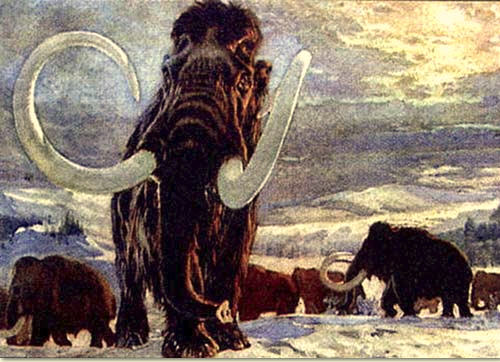
The 50,000 year old fossils and artefacts, among the best preserved in this country, are casting important new light on the lifestyle of Homo neanderthalis (Neanderthal man), the cousin of modem human beings that lived in these islands in the last Ice Age. A 12-week archaeological dig at a gravel pit has revealed a pile of at least seven tusks up to 8ft long, large teeth and partial skeletons from at least four mammoths, together with eight Neanderthal flint hand-axes, teeth from a woolly rhinoceros and reindeer antlers.
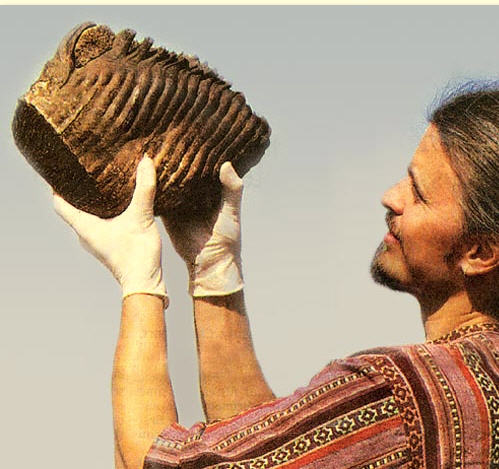
Archeologist Neil Larken with a Mammoth Tooth
The close proximity of the Neanderthal tools and the animal remains - one hand-axe is actually inside a mammoth skull still attached to a tusk - suggests that the site was a hunting hide where the hominids ambushed their prey, or a scavenging ground where the kills of predators, such as sabre-toothed cats and bears, were butchered and eaten. Either way, the discoveries will help scientists to piece together new details of the Neanderthal way of life, solving puzzles about their diet and behaviour.
The Norfolk site contains a network of watering holes, which would have been an ideal spot for either activity. There are no Neanderthal bones or teeth, but their presence has been confirmed from the age of the dig and the style of the hand-axes. Andy Currant, curator of fossil mammals at the Natural History Museum, said that there was clear evidence of Neanderthal activity. "You don't get piles of tusks like this unless someone has gathered them up," he said. "It has to be deliberate. The hand-axe was the Swiss Army knife of the middle Palaeolithic. If you've got one actually in or on a skull, you don't have to worry what else you've got, there's butchery going on. I've never seen anything like this in Britain." David Miles, chief archaeologist for English Heritage, which funded the dig, said: "This is as good an example of a Neanderthal kill site as you will find. This site is not just of national but of international importance."
The best evidence for Neanderthal hunting comes from Germany, but the Norfolk hand-axes offer the strongest indication yet of such hunting in Britain, Mark White, a Palaeolithic archaeologist from Durham University, said: "It is valid to speculate that the Neanderthal had gone to this watering place because they knew they would find prey to kill."
Bill Boismier, of the Norfolk Archaeology Unit, who led the excavation team, said that the absence of cut marks on the bones, together with large numbers of carcass beetle fossils found, made scavenging more likely, although they did not rule out a Neanderthal kill. The excavations are the first to be supported with a grant from the Aggregate Levy Sustainability Fund, which distributes money raised by a tax on gravel quarries to environmental and historical projects in such areas.
Neanderthal Man was present in Europe and Asia from about 130,000 years ago to, about 30,000 years ago, when it was supplanted by modern man, Homo sapiens. Woolly mammoth grew to about the same size as a modern Asian elephant, standing between 8ft and l0ft high at the shoulder and weighing between four and six tonnes when fully grown.
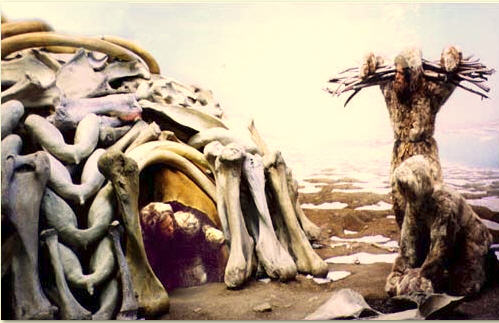
Neanderthal Man was present in Europe and Asia from about
130,000 years ago to about 30,000 years ago.
A report by Imogen Mowday from the 50000 year old Neanderthal site
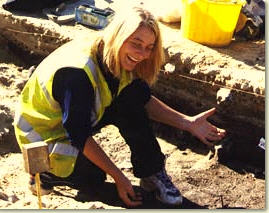 These
images were taken at a newly discovered Neanderthal (Homo neanderthalensis) site in East Anglia dating from approximately
60,000 years ago. Archaeologists continue to work there and are
revealing what may be the most important Palaeolithic site in
Britain since evidence of Homo heidelbergensis, dating from
circa 500,000 years ago, was discovered in Boxgrove in the
1990s. This new site has so far revealed over a dozen bout-coupe
style handaxes, one of which is shown in photograph number one
lodged against fragments of a Woolly Mammoth's tusk. The clear
association of Neanderthal handaxes with a range of Glacial
animal, insect and plant species makes this site the first of
its kind to be found in the U.K.
These
images were taken at a newly discovered Neanderthal (Homo neanderthalensis) site in East Anglia dating from approximately
60,000 years ago. Archaeologists continue to work there and are
revealing what may be the most important Palaeolithic site in
Britain since evidence of Homo heidelbergensis, dating from
circa 500,000 years ago, was discovered in Boxgrove in the
1990s. This new site has so far revealed over a dozen bout-coupe
style handaxes, one of which is shown in photograph number one
lodged against fragments of a Woolly Mammoth's tusk. The clear
association of Neanderthal handaxes with a range of Glacial
animal, insect and plant species makes this site the first of
its kind to be found in the U.K.Imogen Mowday working at the newly discovered site
Woolly mammoth, bears, reindeer and frogs, and hundreds of flint flakes and tools. The exciting discoveries were made during the draining of a lake for gravel extraction. A local archaeologist who is a highly skilled flint-toolmaker (a knapper), was monitoring the gravel extraction to ensure that no archaeology was damaged or not recorded. The site first became clear to him when two large mammoth tusks protruded out from a layer of peat. Immediately work ceased and archaeologists began to record in fine detail the thousands of fragments of animal bones ranging from woolly mammoth to bears, reindeer and frogs, alongside many hundreds of flint flakes and tools.
The site will undoubtedly greatly aid our understanding of
Neanderthal behaviour. As David Miles, chief Archaeologist for
English Heritage, expressed it: "We may have discovered a
butchery site, or, what would be even more exciting, first
evidence in Britain of a Neanderthal hunting site, which would
tell us much about their social abilities". Not only may we
learn about the way in which Neanderthals behaved in order to
obtain food, the discovery of mammoth tusks in a concentrated
area may indicate that the Neanderthals used them to construct
shelters or territorial markers. Therefore the site's finds may
ultimately allow us to make suggestions about the symbolic
behaviour of Neanderthals and allow them to be viewed as highly
intelligent sentient beings, finally removing any old views
depicting them as "primitive".
Missing Link
- The Bradshaw Foundation first revealed this link to modern European Man ten years ago.
- At that time it was reasonable to believe that prehuman Anglia Man evolved into English modern man.
- Recently the Bradshaw Foundation changed into the "Journey of Mankind".
- The old Bradshaw Foundation cannot be accessed even by the WaybackMachine.